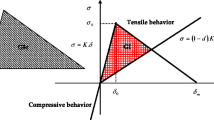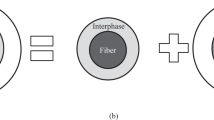Abstract
The paper aims to investigate the suitability of a 3D discrete element method to simulate the thermal-induced damage in composite materials using a cohesive beam model. First, we aim to predict the elastic behavior of continuous material in the case of a homogeneous medium. For that purpose, mechanical tests are performed on a representative pattern and some properties of continuous materials are discussed. Then, we investigate a model of thermal expansion in the context of a homogeneous material to simulate its thermoelastic behavior. The case of a single-inclusion composite is also discussed and some comparisons are done with the finite element method (FEM) and analytical formulations. Damage effects and interfacial debonding are taken into account in order to model the thermal-induced damage due to the thermal expansion mismatch. Finally, a similar study is applied in the context of multi-inclusion composite. From a quantitative standpoint, discrete element results in terms of coefficient of thermal expansion and stress and strain fields are in good agreement with the predictions given by FEM and analytical formulations. Besides, from a qualitative standpoint, the present work exhibits suitable damage modes in accordance with thermal conditions.






























Similar content being viewed by others
References
Krüger R (2002) The virtual crack closure technique: history, approach and applications. Appl Mech Rev 57:109–143
Xu X-P, Needleman A (1994) Numerical simulations of fast crack growth in brittle solids. J Mech Phys Solids 42(9):1397–1434
Zhang Z, Paulino GH (2005) Cohesive zone modeling of dynamic failure in homogeneous and functionally graded materials. Int J Plast 21(6):1195–1254
Liu X, Duddu R, Waisman H (2012) Discrete damage zone model for fracture initiation and propagation. Eng Fract Mech 92:1–18
Moes N, Dolbow J, Belytschko T (1999) A finite element method for crack growth without remeshing. Int J Numer Methods Eng 46:131–150
Rabczuk T, Belytschko T (2007) A three-dimensional large deformation meshfree method for arbitrary evolving cracks. Comput Methods Appl Mech Eng 196(29):2777–2799
Cundall PA, Strack ODL (1979) A discrete numerical model for granular assemblies. Géotechnique 29(1):47–65
Nicot F, Hadda N, Guessasma M, Fortin J, Millet O (2013) On the definition of the stress tensor in granular media. Int J Solids Struct 50:2508–2517
Fillot N, Iordanoff I, Berthier Y (2007) Modelling third body flows with a discrete element method—a tool for understanding wear with adhesive particles. Tribol Int 40(6):973–981
Machado C, Guessasma M, Bellenger E (2015) Electromechanical modeling by dem for assessing internal ball bearing loading. Mech Mach Theory 92:338–355
Machado C, Guessasma M, Bourny V (2018) Electromechanical prediction of the regime of lubrication in ball bearings using discrete element method. Tribol Int 127:69–83
Sanni I, Bellenger E, Fortin J, Coorevits P (2010) A reliable algorithm to solve 3D frictional multi-contact problems: application to granular media. J Comput Appl Math 4:1161–1171
Chen I-W (2000) Grain boundary kinetics in oxide ceramics with the cubic fluorite crystal structure and its derivatives. Interface Sci 8(2):147–156
Pizette P, Martin CL, Delette G, Sornay P, Sans F (2010) Compaction of aggregated ceramic powders: from contact laws to fracture and yield surfaces. Powder Technol 198(2):240–250
Liu X, Hu Z, Wu W, Zhan J, Herz F, Specht E (2017) Dem study on the surface mixing and whole mixing of granular materials in rotary drums. Powder Technol 315:438–444
Haddad H, Guessasma M, Fortin J (2014) Heat transfer by conduction using DEM–FEM coupling method. Comput Mater Sci 81:339–347
Terreros I, Iordanoff I, Charles JL (2013) Simulation of continuum heat conduction using DEM domains. Comput Mater Sci 69:46–52
Jebahi M, André D, Dau F, Charles J l, Iordanoff I (2013) Simulation of vickers indentation of silica glass. J Non-Cryst Solids 378:15–24
Ben Dhia H, Rateau G (2005) The Arlequin method as a flexible engineering design tool. Int J Numer Methods Eng 62(11):1442–1462
Potyondy DO, Cundall PA (2004) A bonded-particle model for rock. Int J Rock Mech Min Sci 41(8):1329–1364
Schlangen E, Garboczi EJ (1996) New method for simulating fracture using an elastically uniform random geometry lattice. Int J Eng Sci 34(10):1131–1144
André D, Iordanoff I, Charles JL, Néauport J (2012) Discrete element method to simulate continuous material by using the cohesive beam model. Comput Methods Appl Mech Eng 213–216:113–125
Leclerc W (2017) Discrete element method to simulate the elastic behavior of 3D heterogeneous continuous media. Int J Solids Struct 121:86–102
André D, Levraut B, Tessier-Doyen N, Huger M (2017) A discrete element thermo-mechanical modelling of diffuse damage induced by thermal expansion mismatch of two-phase materials. Comput Methods Appl Mech Eng 318:898–916
Leclerc W, Haddad H, Guessasma M (2018) On a discrete element method to simulate thermal-induced damage in 2D composite materials. Comput Struct 196:277–291
Tan Y, Yang D, Sheng Y (2009) Discrete element method modeling of fracture and damage in the machining process of polycrystalline sic. J Eur Ceram Soc 29(6):1029–1037
Maheo L, Dau F, André D, Charles JL, Iordanoff I (2015) A promising way to model cracks in composite using discrete element method. Compos B Eng 71:193–202
Chen Z, Jin X, Wang M (2018) A new thermo-mechanical coupled dem model with non-spherical grains for thermally induced damage of rocks. J Mech Phys Solids 116:54–69
Rojek J, Oñate E, Labra C, Kargl H (2011) Discrete element simulation of rock cutting. Int J Rock Mech Min Sci 48(6):996–1010
Hentz S, Donzé FV, Daudeville L (2004) Discrete element modelling of concrete submitted to dynamic loading at high strain rates. Comput Struct 82(29):2509–2524
Sinaie S, Heidarpour A, Zhao XL (2016) A micro-mechanical parametric study on the strength degradation of concrete due to temperature exposure using the discrete element method. Int J Solids Struct 88–89:165–177
Radi K, Jauffrès D, Deville S, Martin CL (2019) Elasticity and fracture of brick and mortar materials using discrete element simulations. J Mech Phys Solids 126:101–116
Schlangen E, Garboczi EJ (1997) Fracture simulations of concrete using lattice models: computational aspects. Eng Fract Mech 57(2):319–332
André D, Jebahi M, Iordanoff I, Charles J-L, Néauport J (2013) Using the discrete element method to simulate brittle fracture in the indentation of a silica glass with a blunt indenter. Comput Methods Appl Mech Eng 265:136–147
Leclerc W, Haddad H, Guessasma M (2017) On the suitability of a discrete element method to simulate cracks initiation and propagation in heterogeneous media. Int J Solids Struct 108:98–114
Le BD, Dau F, Charles JL, Iordanoff I (2016) Modeling damages and cracks growth in composite with a 3D discrete element method. Compos B Eng 91:615–630
Ma Y, Huang H (2018) Dem analysis of failure mechanisms in the intact brazilian test. Int J Rock Mech Min Sci 102:109–119
Boccaccini AR, Chawla KK (1999) Damage development during thermal cycling of metal and glass matrix composites. Woodhead Publishing, Cambridge
Fu Y, Wong YL, Tang CA, Poon CS (2004) Thermal induced stress and associated cracking in cement-based composite at elevated temperatures—part II: thermal cracking around multiple inclusions. Cem Concr Compos 26:113–126
Lu TC, Yang J, Suo Z, Evans AG, Hecht R, Mehrabian R (1991) Matrix cracking in intermetallic composites caused by thermal expansion mismatch. Acta Metall Mater 39(8):1883–1890
Tang SB, Tang CA, Liang ZZ, Zhang YF (2011) Influence of heterogeneity on strength and failure characterization of cement-based composite subjected to uniform thermal loading. Constr Build Mater 25(8):3382–3392
Yan C, Zheng H (2017) A coupled thermo-mechanical model based on the combined finite-discrete element method for simulating thermal cracking of rock. Int J Rock Mech Min Sci 91:170–178
Briche G, Tessier-Doyen N, Huger M, Chotard T (2008) Investigation of the damage behaviour of refractory model materials at high temperature by combined pulse echography and acoustic emission techniques. J Eur Ceram Soc 28(15):2835–2843
Lubachevsky BD, Stillinger FH (1990) Geometric properties of random disk packings. J Stat Phys 60(5):561–583
Donev A, Cisse I, Sachs D, Variano EA, Stillinger FH, Connelly R, Torquato S, Chaikin PM (2004) Improving the density of jammed disordered packings using ellipsoids. Science 303(5660):990–3
Przemieniecki JS (1968) Theory of matrix structural analysis. McGraw-Hill, New York
Fakhimi A, Villegas T (2006) Application of dimensional analysis in calibration of a discrete element model for rock deformation and fracture. Rock Mech Rock Eng 40(2):193
Kumar R, Rommel S, Jauffrès D, Lhuissier P, Martin CL (2016) Effect of packing characteristics on the discrete element simulation of elasticity and buckling. Int J Mech Sci 110:14–21
Liao C, Chang T-P, Young D-H, Chang C (1997) Stress–strain relationship for granular materials bases on hypothesis of best fit. Int J Solids Struct 34:4087–4100
Hashin Z, Shtrikman S (1963) A variational approach to the theory of the elastic behaviour of multiphase materials. J Mech Phys Solids 11(2):127–140
Levin VM (1967) On the coefficients of thermal expansion of heterogeneous materials. Mekhanika Tverdogo Tela 2:58–61
Zhou M (2003) A new look at the atomic level virial stress: on continuum-molecular system equivalence. Proc R Soc Lond A Math Phys Eng Sci 459(2037):2347–2392
Hahn M, Schwarz M, Kröplin B-H, Wallmersperger T (2011) Discrete element method for the thermal field: proof of concept and determination of the material parameters. Comput Mater Sci 50(10):2771–2784
Moukadiri D, Leclerc W, Kamel K, Aboura Z, Guessasma M, Bellenger E, Druesne F (2019) Halo approach to evaluate the stress distribution in 3D discrete element method simulation: validation and application to flax/bio based epoxy composite. Model Simul Mater Sci Eng 27(6):065005
Acknowledgements
The authors would like to thank the European Union for its financial support of CUBISM project under the INTERREG V France-Wallonie-Vlaanderen Program FWV \(\hbox {N}^\circ \) 1.1.22.
Author information
Authors and Affiliations
Corresponding author
Ethics declarations
Conflict of interest
The authors declare that they have no conflict of interest.
Additional information
Publisher's Note
Springer Nature remains neutral with regard to jurisdictional claims in published maps and institutional affiliations.
Rights and permissions
About this article
Cite this article
Alhajj Hassan, G., Leclerc, W., Pélegris, C. et al. On the suitability of a 3D discrete element method to model the composite damage induced by thermal expansion mismatch. Comp. Part. Mech. 7, 679–698 (2020). https://doi.org/10.1007/s40571-019-00298-1
Received:
Revised:
Accepted:
Published:
Issue Date:
DOI: https://doi.org/10.1007/s40571-019-00298-1




